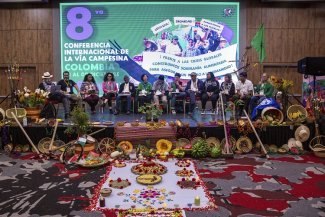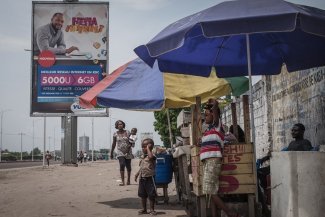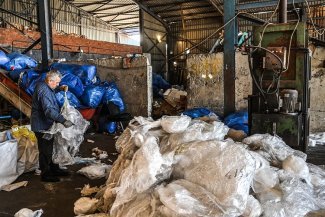We live in a world that overproduces food, and “the problem is that what is being produced is designed to feed a business that is very good at selling edible things and very bad at feeding people”.
In 2016, Marcos Filardi set off on a voyage of discovery: over the course of one year, he visited 260 localities throughout Argentina and mapped the different food sovereignty initiatives being undertaken in the provinces. “The first thought that my journey left me with is that I found much more than I had imagined; and if now, three years later, I were to do it again, I would have many more experiences,” said the lawyer, a specialist in human rights and food sovereignty.
Argentina is perhaps one of the countries in the world where agribusiness has taken its strongest hold: 60 per cent of the country’s arable land has been taken over by genetically-modified soya, the crop invented by the multinational Monsanto and which is resistant to glyphosate-based agrochemicals.
However, or perhaps for that very reason, Argentina is also a hotbed of resistance: “Some ‘face-to-face with the monster’ such as the communities which are fighting against crop spraying or trying to halt the expansion of agribusiness; others ‘with their backs to the monster’ building something new or recovering what already existed,” says Filardi. He took the metaphor from Jonathan Nossitter, a filmmaker fascinated with ‘natural’ viticulture and author of the book Cultural Uprising. In this work he questions, among other things, the way we have resigned ourselves to it being ‘normal’ to use pesticides: a ‘poison-dependent’ model that destroys soils and diversity and makes our bodies sick,” says Filardi.
Among the discoveries the lawyer made during his trip, those that stood out included extensive agroecological production, suggesting that agroecology does not need to be restricted to a small vegetable patch in someone’s back garden or in a school, but that it could also be part of a large production unit. Guaminí is one pioneering initiative, in which some producers have grouped together to produce agroecological wheat; the local authorities made a mill available to them using public funds, and they sell agroecological flour below the market price. In this way they are challenging one of the most ingrained myths: that agroecological foods are bound to be more expensive and that therefore only the wealthiest can afford healthy food.
Among the retail initiatives to have flourished as an alternative to the dominant supermarket model is the consumer cooperative, open fairs where the producer comes face to face with the diner – a term which is preferred among the ‘resistance’ to diner – while another is the dedicated planting session in which a group of urban diners plan the sowing and harvesting with the producer.
“The market is much more than the place where supply meets demand: a whole web of senses is woven there; and when the diner takes the hoe and feels the pain around their middle after a day of working in the field, I can assure you they are not going to haggle over the price of vegetables,” says Filardi.
One of the marketing models – aimed at eliminating intermediaries – that has proliferated most successfully in the big cities in recent years is the direct sale of bags of fruit and vegetables.
Pueblo a Pueblo (Town to Town) is an initiative by MET Rural, part of the Excluded Workers Movement. “Pueblo a Pueblo is based on the need to avoid the long chain of intermediaries in the conventional market, which sometimes leads to the producing families being paid less than the cost of production,” explains Pablo Aristide, one of the organisers. “The producers prepare five kilo bags which are taken to different points in the city where they are collected on designated days. This has meant that the producing families have had to organise in groups to take decisions about the price and composition of the bags, which has involved interesting changes as they switch to a more collective way of working,” he adds.
The ‘back to the monster’ experiments coexist with the ‘resistance’ that is going face-to-face with the hegemonic model. Filardi’s mapping of initiatives during his travels has served above all to create networks among those concerned, many of whom take part in the Public Lectures on Food Sovereignty which flourish throughout the country. This network was added to last November with the creation of the Lawyers Network for Food Sovereignty (Red de Abogadas y Abogados por la Soberanía Alimentaria - REDASA) in Buenos Aires and which includes members from Uruguay, Brazil, Bolivia, Honduras and Argentina. Its aim is to bring together lawyers who work on the issue of food sovereignty from different angles: litigation, research or legislative advice. They are now trying to create similar networks in Asia and Africa, as well as a global one. For while the solutions in each country may be local, the problems they face are global.
Hunger as a legitimising argument
Since the Green Revolution, when the use of pesticides and herbicides to increase crop productivity began to expand between the 1950s and the 1960s, ending hunger has been the central argument for legitimising an agricultural model that, starting in the 1980s, was presented as agribusiness, with a growing role for finance and an accelerated corporatisation of the sector. The idea being put across is that it would be utopian to think that the kind of initiatives Filardi encountered on his trip could feed the populations of the big cities.
“The agrifood system is controlled by a handful of corporations at the global level: the five grain companies that monopolise the marketing of grains, the four chemical companies that concentrate the herbicide, fertiliser and seed market; the eight or ten corporations of the agrifood industry, the five distribution giants, the seven oil companies,” sums up Filardi.
The problem, therefore, was never one of production, but of distribution and access to food. That is to say: it is not a technical question, but a political one. This is demonstrated by food waste: according to the FAO, every year 1300 million tons of food end up in the waste bin, a third of total production. And much of the large areas dedicated to monoculture is used for other purposes than human consumption, such as the manufacture of biofuels.
“What is utopian is to think that this agroindustrial system can have a future. We live in a world that overproduces things, including food; the problem is that what is being produced is to feed a business that is very good at selling edible things and very bad at feeding people; a model that needs cheap ingredients to ultra-process them and disguise them as a false variety that doesn’t belong to our fields, nor our supermarket shelves nor our dining tables,” argues the Argentine journalist Soledad Barruti, author of the book Mala leche. The supermarket as an ambush (Planeta, 2018). “That lie explodes in our bodies in the form of diseases and it devastates our land in Latin America, which is a paradise of genetic diversity,” she adds.
Another question is whether the agroindustrial and agroecological models can coexist. Filardi replies: “No, one model eats up the other, first because as their frontiers advance conflict follows, and also because it is simply not feasible: if my neighbour plants genetically modified corn, it contaminates all my produce.” Wind and water know little about borders.
A prime example is the La Aurora fields, 670 hectares of agroecological production in the south of the province of Buenos Aires, where herbicides have not been used for 27 years; however, when the field is analysed there are residues of glyphosate and other herbicides that, Filardi explains, “are brought by rainwater, filtration, run-off.” Yes, even rainwater is a culprit: last year, scientists from the National Scientific and Technical Research Committee (Conicet) demonstrated the presence of glyphosate and other toxic substances in samples of rainwater collected in the provinces of Santa Fe, Córdoba and Buenos Aires.
Leaving this model cannot be done individually. “Food is collective: you can act on an individual level, but those actions will be short-lived. This is obvious when we have children: if we do not want them to eat ultra-processed food, we will have to have great conviction to maintain that, and even then, your kids will pay for it, they will end up being seen as the weird ones. Furthermore, the impact of this model affects us even if we do not participate in it: the risk of resistance to antibiotics generated by the abuses of industrial livestock affects us all, even if we do not eat that chicken or that cow,” says author Soledad Barruti.
“Argentina is the second largest exporter of organic [produce, be it fruit and vegetables or meat – with a livestock production that is concentrated in Patagonia]. And all that is exported at the expense of the quality of our food, [i.e.] the organic cow is foreign,” says Filardi. The lawyer who specialises in human rights and food sovereignty refers to the words by singer-songwriter Atahualpa Yupanqui to sum up the colonisation of economic power in two unforgiving lines: “The sorrows are ours/The cows belong to others.”










